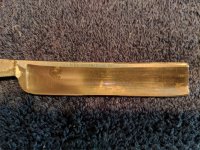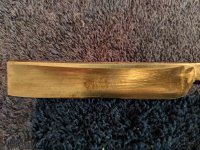First, let me say thank you. The folks on the B&B forums have been an enormous source of help and encouragement. So, from all of us on the less experienced end of things, thanks.
As I am trying to learn honing I have bought several fleaBay cheapies to practice upon. I'm noticing that I can get a reasonable edge on some/most, but not on others. I know they are good steel and can take a shaveable edge, though the resulting shave is not a comfortable one.
It's seems to consistently be the razors that show significantly more spine wear that seem to not want to get sharp. The ones that have a well defined flat surface on the side of the spine that's wider than the width of the spine itself. Clearly the recipient of many prior honings.
So, the question is, is spine wear a good indicator of how much life is left in the blade? And if so, what's an upper limit of visible wear that would still leave us reasonably confident that the blade will take a fine edge?
Again, thanks ...
-- Alan
As I am trying to learn honing I have bought several fleaBay cheapies to practice upon. I'm noticing that I can get a reasonable edge on some/most, but not on others. I know they are good steel and can take a shaveable edge, though the resulting shave is not a comfortable one.
It's seems to consistently be the razors that show significantly more spine wear that seem to not want to get sharp. The ones that have a well defined flat surface on the side of the spine that's wider than the width of the spine itself. Clearly the recipient of many prior honings.
So, the question is, is spine wear a good indicator of how much life is left in the blade? And if so, what's an upper limit of visible wear that would still leave us reasonably confident that the blade will take a fine edge?
Again, thanks ...
-- Alan


